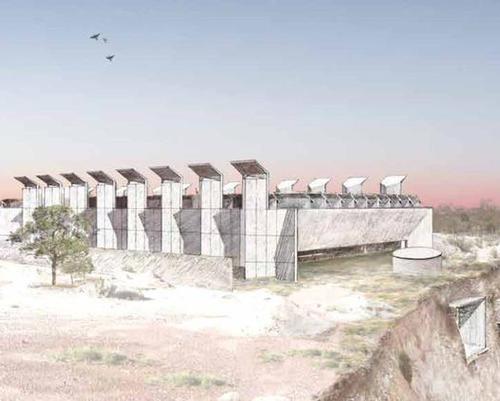19 Dec 2017
Glenn Murcutt and Wendy Lewin design submerged home for Australian opal museum
BY Kim Megson

Pritzker laureate Glenn Murcutt and architect Wendy Lewin are designing a museum in the Australian Outback to showcase the world’s greatest public collection of rare opalised fossils from the Age of Dinosaurs.
The Australian Opal Centre will be built in the mining town of Lightning Ridge, constructed within a giant void excavated from the earth in 2013. The project is being funded by the New South Wales government, business donations and crowdfunding.
Conceived as “a 21st-century architectural icon, a world-class tourist attraction and nationally-significant facility”, the two-storey building will stretch 100m (330ft), much of it underground.
Visitors will approach via the historic Three Mile opal field and into a structure “recessed into, and protected by the earth.” A long, gently descending ramp will take them below ground and into the side of an open-cut mine, “with the geological strata of opal-bearing country exposed before them”.
The journey will then continue into the permanent exhibitions, education and learning facilities, a cinema, gallery spaces, a research library, a scientific laboratory and underground gardens.
Lewin and Murcutt’s design will be brought to life using a combination of ancient and modern technologies that allow the building to provide its own energy, water, light and fresh air, without being connected to mains power or water.
The large roof will collect rainwater and solar energy, with water stored underground and recycled for use in the garden. Gradients of air temperature and pressure will drive passive ventilation systems, “not unlike those used by opal miners to keep fresh air flowing through their mines”.
“Innovations in design, materials and processes will generate new paradigms for the future of public architecture in semi-arid Australia,” said the Australian Opal Centre in a statement.
“The building design will conserve water and energy, minimise running costs and attract hundreds of thousands of visitors from around Australia and the world.”
Murcutt’s previous public buildings include the Museum of Local History and Tourist Office, Kempsey and the Arthur and Yvonne Boyd Education Centre, Illaroo.
He was awarded the Pritzker Prize – architecture’s highest honour – in 2002. That year’s jury chair, J Carter Brown, said: “He's an innovative architectural technician, capable of turning his sensitivity to the environment and to locality into forthright, totally honest, non-showy works of art.”
Close Window